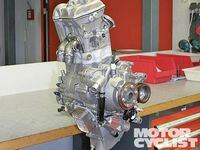KTM’s new Moto3 engine was unveiled just as the FIM released full details of the class rules. The Austrian company’s engine is a purposeful new design, but it’s also a fairly conventional effort in the face of the radical cost-cutting nature of this 250c four-stroke class that is replacing the 125cc two-strokes.
The KTM single is almost a slice off a MotoGP four, but neither pneumatic nor other non-metallic valve springs can be used. Bore is a maximum of 81mm. Valves, connecting rod and fasteners can be titanium while the rest of the engine must use more conventional materials such as aluminum and steel. A chain must be used to drive the cams (with an intermediate gear allowed).
A Dell’Orto ECU is standard for all Moto3 engines and limits revs to 14,000 rpm. Mapping is, of course, tunable, but software can’t be changed. The ECU has some traction-control and slipper-clutch compatibility but the throttle plate must be controlled mechanically by the rider with no ECU involvement. Only two injectors are allowed, but there can be no variable intake or exhaust geometry. The transmission must be a conventional six-speed with no “seamless-shift” technology, and there can be only one different gearset for ratio changes.
But this is just the beginning of the new rules, and from here it gets radical: These engines can cost no more than €12,000 (approximately $16,000).
That sounds pretty simple: Order an engine from Honda or KTM for €12K, then order up a race kit, right? Nope: The total cost of the engine including any factory or aftermarket race kit must not exceed €12K.
Going further, if there is no race kit, just a catalog of available parts, the total for those parts must not exceed €12K. If the manufacturer’s camshaft costs €300, then the aftermarket company’s performance upgrade has to cost €300.
Engines can be modified somewhat, but any team can claim another’s engine after a race. Price? €12K, to discourage expensive modifications.
Engines are effectively sealed at tech inspection. Most internal parts can’t be worked on during a race weekend. Valves can be adjusted only if the camshafts don’t need to be removed to do the job.
It gets even more complex, because the manufacturer has to make enough engines to supply eight teams the first year and 15 teams thereafter. A team (considered one bike and rider) can use eight engines during the season, which is a little more than two weekends of racing per engine. Fifteen teams thus might use 120 engines over the course of the year. All these engines have to be equal when delivered; a manufacturer can’t make a few special engines for a certain team and a standard engine for the rest. An aftermarket manufacturer can’t offer a few race kits, either; it has to build enough to cover all the manufacturers’ engines.
The intent of the rules is to standardize engine prices and equalize performance as much as possible. Rules governing the chassis are much more open, requiring prototype designs, without price caps. Minimum weight for the bike and rider together is 148 kilograms (326 lbs.), which means that a 130-lb. rider will pass tech with a 196-lb. bike.
The intent of Moto2 rules also was to equalize performance, but we’ve seen that series’ leading teams already spending two or three times the amount of the mid-field runners, and there have only been three winners this season. There has been good racing, but Moto2 is already looking a bit too much like a 600cc version of MotoGP.
Moto3’s rules are even more stringent, but will a few teams find ways to spend the money to tip things in their favor and dominate the field? The FIM hopes its Moto3 rules will make for more winners, and more contenders. That should make for more entertaining television, bigger audiences, and, it’s hoped, profit for the sponsors.













/cloudfront-us-east-1.images.arcpublishing.com/octane/HXOUJXQWA5HBHGRO3EMJIGFMVI.jpg)

/cloudfront-us-east-1.images.arcpublishing.com/octane/3TIWWRV4JBBOLDVGRYECVVTA7Y.jpg)
/cloudfront-us-east-1.images.arcpublishing.com/octane/KIX5O23D5NAIBGFXBN3327DKZU.jpg)
/cloudfront-us-east-1.images.arcpublishing.com/octane/7GJYDUIPXRGMTMQKN6ONYOLBOU.jpg)
/cloudfront-us-east-1.images.arcpublishing.com/octane/MUQLOVLL2ZDGFH25ILABNBXKTI.jpg)
/cloudfront-us-east-1.images.arcpublishing.com/octane/TNOU5DNE2BC57MFPMGN2EIDXAM.jpg)
/cloudfront-us-east-1.images.arcpublishing.com/octane/GTCXACQGJ5HAPDTGWUQKDEH44E.jpg)
/cloudfront-us-east-1.images.arcpublishing.com/octane/S35YGSEMEZB4BLTDJTSZPF4GLA.jpg)
/cloudfront-us-east-1.images.arcpublishing.com/octane/5UOT6HPX2JFMRJAX6EH45AR4MQ.jpg)
/cloudfront-us-east-1.images.arcpublishing.com/octane/OKWOJWAKP5EP3OACCRRWPCIX2Q.jpg)
/cloudfront-us-east-1.images.arcpublishing.com/octane/2WF3SCE3NFBQXLDNJM7KMXA45E.jpg)
/cloudfront-us-east-1.images.arcpublishing.com/octane/G4MG6OUCJNBSHIS2MVVOTPX65E.jpg)
/cloudfront-us-east-1.images.arcpublishing.com/octane/IIGGWFOTOJGB7DB6DGBXCCMTDY.jpg)
/cloudfront-us-east-1.images.arcpublishing.com/octane/QSTCM6AVEZA5JJBUXNIQ3DSOF4.jpg)
/cloudfront-us-east-1.images.arcpublishing.com/octane/U4I7G625B5DMLF2DVIJDFZVV6M.jpg)
/cloudfront-us-east-1.images.arcpublishing.com/octane/B6XD6LS6IVCQPIU6HXDJSM3FHY.jpg)
/cloudfront-us-east-1.images.arcpublishing.com/octane/ICL63FEDDRDTTMINYICCEYGMDA.jpg)
/cloudfront-us-east-1.images.arcpublishing.com/octane/FCGZHQXRBZFLBAPC5SDIQLVF4I.jpg)
/cloudfront-us-east-1.images.arcpublishing.com/octane/WNOB6LDOIFFHJKPSVIWDYUGOPM.jpg)

/cloudfront-us-east-1.images.arcpublishing.com/octane/X33NU3E525ECRHXLNUJN2FTRKI.jpg)
/cloudfront-us-east-1.images.arcpublishing.com/octane/6KKT5NNL2JAVBOXMZYS5ZO76YA.jpg)
/cloudfront-us-east-1.images.arcpublishing.com/octane/J5RKG5O455GMPGQRF2OG6LRT7A.jpg)